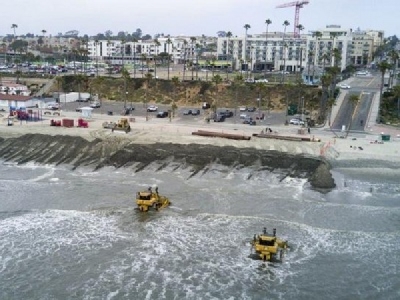
Posted on August 14, 2018
Photos of Oceanside and Carlsbad beaches taken prior to the mid-1940s show broad, sandy beaches, with room for tents, cars and large public gatherings.
Today, most of those beaches, without artificial restoration, are narrow strips of cobblestone.
An experimental sand bypass system used almost 30 years ago is one of the ideas Oceanside wants to reconsider for feeding its emaciated beaches.
The federally funded bypass program worked from 1989 to 1993, vacuuming sand from the Oceanside harbor year-round and pumping it as far south as the shore of Tyson Street Park, nearly a mile away.
Although the project initially got high marks from city officials and the U.S. Army Corps of Engineers, there were mechanical problems and cost overruns, and after four years it fell from the federal budget. After that, the Corps returned to the annual dredging that had kept the harbor open since it was built in the 1960s.
The one-of-a-kind system is one of several possibilities the city wants to discuss as replacements for the recent failed efforts of the U.S. Army Corps of Engineers. A presentation is scheduled when the Oceanside City Council meets at 5 p.m. Wednesday.
“It’s not cheap,” Mayor Peter Weiss said recently.
Sand projects cost millions of dollars, but the lack of sand is costly, too, in terms of lost tourism, reduced property values and other long-term effects.
One possible method of financing the project could be the half-cent sales tax increase that Oceanside voters will see on the November ballot, he said.
“I’d like to at least have staff look into it,” Weiss said, to see if maybe the city can launch its own sand restoration project at a reasonable cost.
The long-defunct bypass system is among a number of possibilities outlined in a staff report to the City Council.
“It has been suggested that staff develop a city-sponsored beach sand replenishment project or revitalize the previous sand-bypass system,” states a memorandum from Oceanside Public Works Director Kiel Koger.
“The city would be required to provide all funding and resources for the initial studies, permitting, design and construction, although some partial funding assistance may be available at the state or federal levels,” Koger states.
Naturally occurring offshore sand deposits are another possible source of beach nourishment.
A $23 million effort by the San Diego Association of Governments in 2012 pumped a total of 1.5 million cubic yards of sand from several offshore locations onto 10 different county beaches, including Oceanside.
Sites that received the sand were initially an average of 33 feet wider and three to six feet higher as a result.
Oceanside beaches south of Tyson Street Park are looking especially stark this year because the Corps of Engineers cancelled the annual spring harbor dredging, which is an important source of sand.
Typically, the dredging removes about 250,000 cubic yards of sand from the harbor and pipes it to the beach. Last year, on top of the base $3.7 million federal contract, the city paid $600,000 and the Navy and the Corps of Engineers added $625,000 to boost the amount dredged to 440,000 cubic yards.
Another Corps of Engineers project also fell through last year that also would have added sand to the city’s beaches.
The Corps’ San Luis Rey River flood-control project failed to launch in October after multiple delays, largely because of problems obtaining the required permits. That effort was expected to remove 230,000 cubic yards of sediment to widen and deepen the river channel, with most of the beach-quality sand going to Oceanside’s Buccaneer Beach and farther south.
Another Oceanside project with more long-term effects appears to have been placed on hold by the Corps.
The Corps’ three-year “shoreline feasibility study,” begun in 2016, was created to examine the effects the Camp Pendleton harbor, built in 1942, has had on Oceanside beaches. The Pendleton and Oceanside harbors share the same entrance.
However, the study stalled last year after the federal government informed the city it would have to shoulder half the $1.8 million costs, or agree to reduce the scope of the study.
Reducing the scope of the feasibility study would make it more difficult to qualify for future sand restoration or shoreline protection projects, city officials say.
Previous studies have shown that the creation of the two harbors, and especially the jetties that protect their shared entrance, have altered the north-south ocean current and increased beach erosion south of the entrance.
Other factors in beach erosion include sea-level rise, bluff and shoreline protection devices, and upstream development in nearby watersheds.
Source: The San Diego Union-Tribune





